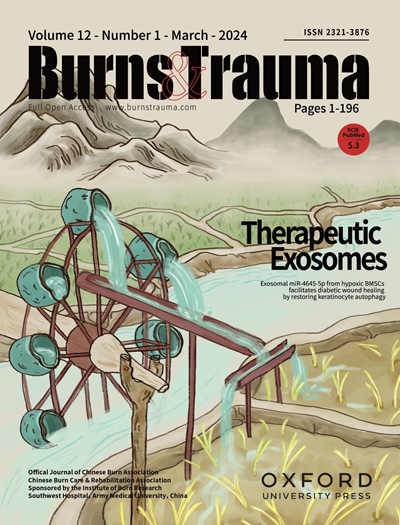Adipose Mesenchymal Stem Cell-derived Exosomes Rescue Mitochondrial Function through SIRT1 to Improve Diabetic Wound Healing
IF 9.6
1区 医学
Q1 DERMATOLOGY
引用次数: 0
Abstract
Background Diabetic wounds represent the most common type of chronic wounds. Persistent inflammation and elevated oxidative stress are hallmark features of chronic wounds, where macrophage phenotypic polarization playing a critical role in the healing process. Although adipose-derived mesenchymal stem cell exosomes (ADSC-exos) have shown therapeutic potential for diabetic wounds, their precise mechanisms remain elucidated. Methods A streptozotocin-induced diabetic mouse model and high glucose-stimulated RAW 264.7 macrophages were utilized to mimic diabetic microenvironments. Wound tissues were collected from patients with diabetic foot ulcer. A skin incision model was established in mice and ADSC-exos were given subcutaneously. Streptozotocin-induced diabetic myeloid-specific sirt1−/− mice SIRT1 siRNA-transfected macrophages were employed to investigate the role of SIRT1 in vivo and in vitro. Wound healing rates were quantified. Mitochondrial function, lysosomal activity, autophagy flux, and inflammation status were systematically assessed. Results In diabetic mice and high glucose-treated macrophages, lysosomal dysfunction preceded mitochondrial and autophagy flux impairments. SIRT1 expression was significantly reduced in both diabetic wound tissues and macrophages, accompanied by M1 macrophage polarization. SIRT1 interference experiments revealed that the impact of ADSC-exos on mitochondrial function, autophagy flux, and inflammatory response were partially dependent on SIRT1. Notably, the therapeutic effects of ADSC-exos on mitochondrial and autophagic pathways were markedly attenuated upon SIRT1 suppression. Conclusions These findings demonstrate that ADSC-exos promotes diabetic wound healing by restoring mitochondrial function and autophagy via SIRT1 activation. These findings highlight the therapeutic potential of ADSC-exos and provide a mechanistic foundation for future exosome engineering strategies.脂肪间充质干细胞来源的外泌体通过SIRT1改善糖尿病伤口愈合来拯救线粒体功能
糖尿病性伤口是最常见的慢性伤口类型。持续的炎症和氧化应激升高是慢性伤口的标志性特征,其中巨噬细胞表型极化在愈合过程中起着关键作用。尽管脂肪源性间充质干细胞外泌体(ADSC-exos)已显示出治疗糖尿病伤口的潜力,但其确切机制仍未阐明。方法采用链脲佐菌素诱导的糖尿病小鼠模型和高糖刺激的RAW 264.7巨噬细胞模拟糖尿病微环境。收集糖尿病足溃疡患者的创面组织。建立小鼠皮肤切口模型,皮下注射ADSC-exos。利用链脲佐菌素诱导的糖尿病骨髓特异性sirt1 - / -小鼠sirt1 - sirna转染巨噬细胞,研究sirt1在体内和体外的作用。量化伤口愈合率。系统评估线粒体功能、溶酶体活性、自噬通量和炎症状态。结果在糖尿病小鼠和高糖处理的巨噬细胞中,溶酶体功能障碍先于线粒体和自噬通量损伤。SIRT1在糖尿病创面组织和巨噬细胞中的表达均显著降低,并伴有M1巨噬细胞极化。SIRT1干扰实验显示,ADSC-exos对线粒体功能、自噬通量和炎症反应的影响部分依赖于SIRT1。值得注意的是,在SIRT1抑制后,ADSC-exos对线粒体和自噬途径的治疗作用明显减弱。这些发现表明,ADSC-exos通过激活SIRT1来恢复线粒体功能和自噬,从而促进糖尿病伤口愈合。这些发现突出了ADSC-exos的治疗潜力,并为未来的外泌体工程策略提供了机制基础。
本文章由计算机程序翻译,如有差异,请以英文原文为准。
求助全文
约1分钟内获得全文
求助全文
来源期刊

Burns & Trauma
医学-皮肤病学
CiteScore
8.40
自引率
9.40%
发文量
186
审稿时长
6 weeks
期刊介绍:
The first open access journal in the field of burns and trauma injury in the Asia-Pacific region, Burns & Trauma publishes the latest developments in basic, clinical and translational research in the field. With a special focus on prevention, clinical treatment and basic research, the journal welcomes submissions in various aspects of biomaterials, tissue engineering, stem cells, critical care, immunobiology, skin transplantation, and the prevention and regeneration of burns and trauma injuries. With an expert Editorial Board and a team of dedicated scientific editors, the journal enjoys a large readership and is supported by Southwest Hospital, which covers authors'' article processing charges.
 求助内容:
求助内容: 应助结果提醒方式:
应助结果提醒方式:


